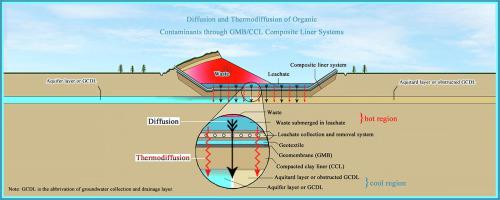Waste Management ( IF 7.1 ) Pub Date : 2020-10-31 , DOI: 10.1016/j.wasman.2020.10.004 Ming-Qing Peng , Shi-Jin Feng , Hong-Xin Chen , Zhang-Long Chen , Hai-Jian Xie

|
A new analytical model for organic contaminant transport through GMB/CCL (geomembrane and compacted clay liner) composite liner is developed, which can consider adsorption, diffusion and thermodiffusion processes and is applicable for typical bottom boundary conditions. The separation of variables method is adopted to derive the solution. The present model is first verified against experimental results and a numerical model. The influence of thermodiffusion on organic contaminant transport in composite liner is then investigated. Toluene is adopted as the representative organic contaminant. The results reveal that when the Soret coefficient ST is not less than 0.01 K−1, the effect of thermodiffusion should be taken into account on the contaminant transport in GMB/CCL composite liner in wet landfills. When the Soret coefficient ST is 0.03 K−1, the breakthrough time of a GMB + 0.75 m CCL composite liner and a 2 m CCL would be overestimated by 20% to 76% due to omitting of the effect of thermodiffusion. Namely, the barrier performance would be greatly overestimated if the effect of thermodiffusion is neglected in these cases. In other aspects, the thermal conductivity of GMB and CCL has little effect on the contaminants transport in GMB/CCL composite liners, so there is no need to modify the materials for this parameter. The present model is an applicable tool for evaluating the barrier performance of the GMB/CCL composite liner, and can provide valuable advices for improving the liner materials.
中文翻译:

考虑吸附,扩散和热扩散的有限厚度有机污染物通过GMB / CCL复合衬里的分析模型
建立了一种新的有机污染物通过GMB / CCL(土工膜和压实粘土衬里)复合衬里运输的分析模型,该模型可以考虑吸附,扩散和热扩散过程,适用于典型的底部边界条件。采用变量分离法求出解。首先对照实验结果和数值模型验证了本模型。然后研究了热扩散对复合衬里有机污染物迁移的影响。甲苯被用作代表性的有机污染物。结果表明,当Soret系数S T不小于0.01 K -1时,应考虑热扩散对湿垃圾填埋场中GMB / CCL复合衬里污染物迁移的影响。当Soret系数S T为0.03 K -1时,由于省略了热扩散效应,GMB + 0.75 m CCL复合衬里和2 m CCL的穿透时间将被高估20%至76%。即,如果在这些情况下忽略了热扩散的影响,则隔离性能将被大大高估。在其他方面,GMB和CCL的热导率对GMB / CCL复合衬里中的污染物传输影响很小,因此无需为此参数修改材料。本模型是评估GMB / CCL复合衬里阻隔性能的适用工具,可为改进衬里材料提供有价值的建议。











































 京公网安备 11010802027423号
京公网安备 11010802027423号